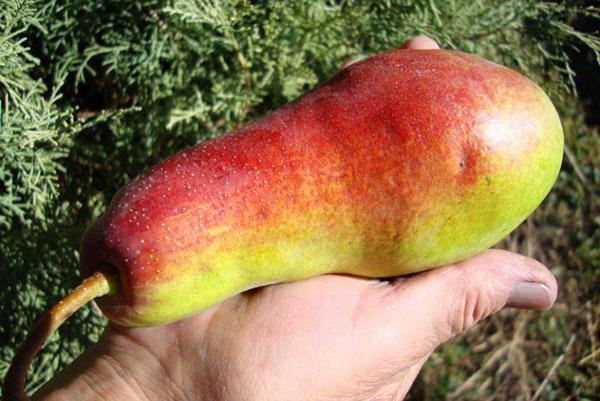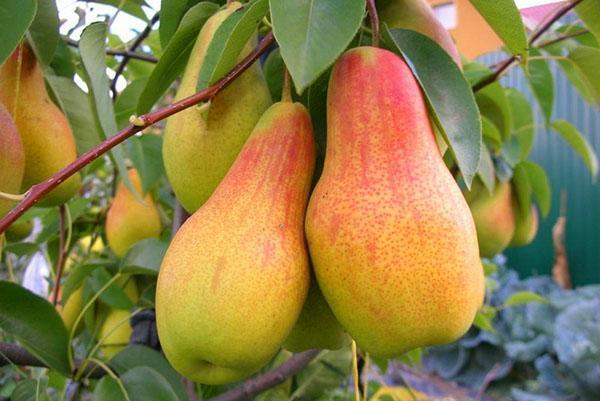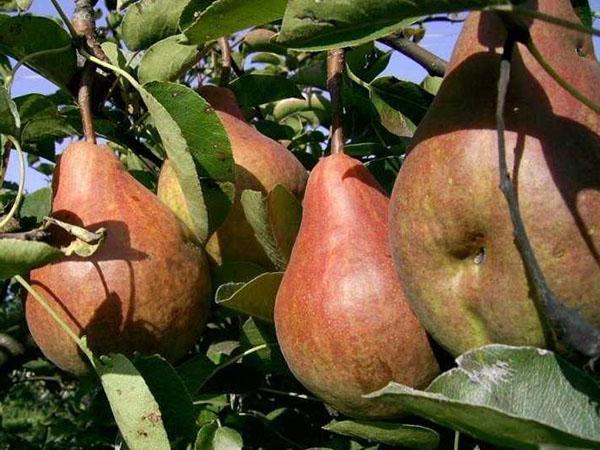Your garden will be decorated with pear Talgar beauty
 Admire, before you a pear Talgar beauty - description, photos cannot convey the taste and aroma of the fruit. But imagine the warm weight in the palm of your hand and the aroma emanating from the ripe fruit. This miracle is stored all winter, and it becomes even tastier. Just do not be late with the harvest. Plant the Talgar beauty pear variety in your garden - this tree has many advantages!
Admire, before you a pear Talgar beauty - description, photos cannot convey the taste and aroma of the fruit. But imagine the warm weight in the palm of your hand and the aroma emanating from the ripe fruit. This miracle is stored all winter, and it becomes even tastier. Just do not be late with the harvest. Plant the Talgar beauty pear variety in your garden - this tree has many advantages!
Description of the variety

Skeletal branches extend from the trunk at right angles. The branches that grow and bear fruit are drooping, from which the tree is grounded. The bark is gray, scaly. The tree has a high winter hardiness, it is cultivated everywhere in the European part of Russia.
The scourge of fruit trees is disease and pests. One of the most important characteristics of the Talgar beauty pear variety according to the description and photo is its resistance to pests and diseases. It is important that scab does not affect this pear variety. The number of chemical treatments is reduced to a minimum, which means that pure fruits will fall on the family table.
 The Talgar beauty begins to bear fruit for 5 years after planting. Fruiting is regular. The tree is not demanding to care, grows on poor soils, but, like other Pears, it loves a sunny open place and a low standing groundwater. Top dressing and watering will add yield and sweeten the fruit. The characteristics of the Talgar beauty pear variety are only positive.
The Talgar beauty begins to bear fruit for 5 years after planting. Fruiting is regular. The tree is not demanding to care, grows on poor soils, but, like other Pears, it loves a sunny open place and a low standing groundwater. Top dressing and watering will add yield and sweeten the fruit. The characteristics of the Talgar beauty pear variety are only positive.
The fruits are large, elongated, beautifully shaped, somewhat reminiscent of a bottle with a beveled bottom. Weight of one copy is about 200 g. A smooth light green pear with blush looks beautiful. The subcutaneous points create a mysterious pattern. The pulp is fine-grained, juicy, crispy. Not all amateurs appreciate this. But everyone agrees that the fruits are mature, and the taste only improves during storage.
The pear for storage must be removed before it ripens. If ripe fruits hang on the tree for a long time, the flesh turns brown and the taste deteriorates. The Talgar beauty pear is harvested in September.
Admire the photo of the Talgar beauty pear tree, burdened with the harvest:
Agrotechnics of pears varieties Talgar beauty
Care for a fruit tree and a seedling is different. A mature tree is more patient with temporary adversity. A young seedling in 5 years should lay the foundation for future fruiting. But some operations during planting and caring for the Talgar beauty pear require special attention:
- correct fit;
- watering and feeding;
- trimming;
- protective measures;
- shelter for the winter.
Despite the unpretentiousness of an adult tree, the seedling needs to be taken care of. A healthy two-year-old with a developed root system is immersed in water for a day or 36 hours.
A hole is dug on a sunny slope; on the north side, the new plant must be protected with a screen. A pit up to 1 m deep is equipped with a drainage layer of stones, broken bricks, covered with sand, and a support stake is driven in. A mound is poured from the fertile land, the roots are spread on it.Sprinkle the roots with fertile soil a few centimeters, then you can add a mixture of superphosphate and potassium salt. The roots should not get a chemical burn from contact with fertilizers when watering.  The soil on the roots is compacted, trampled so that the place of the scion is above the ground. The watering bowl is mulched.
The soil on the roots is compacted, trampled so that the place of the scion is above the ground. The watering bowl is mulched.
To support the young seedling, a stake is driven into the ground. It doesn't have to be an iron rod or pipe - it's cold in winter. To prevent the wooden stake from rotting longer, you can slightly char the end at the stake, choose larch. When mulching, there should be free space near the trunk - from diaper rash.
Watering is carried out throughout the season. For this, circular grooves are dug. Up to 2 buckets of water are poured onto one tree. The soil should be moist, but not wet. Seedlings are watered 3 times a week, trees - 4 times a month. In the first year, seedlings are not fertilized. Later, in spring, dry urea or ammonium nitrate is embedded in the soil in grooves at a shallow depth. When watering, the fertilizer will nourish the soil. After harvesting, the tree is fed with compost, phosphoric and potash fertilizers.
For the winter, pears in the risky gardening zone insulate pre-cleaned and whitewashed trees. A good covering material is a special non-woven fabric. It allows the tree to breathe while protecting it.
 The formation of the tree begins from the second year, leaving a single central shoot. When pruning, the internal branches are removed so as not to thicken the crown.
The formation of the tree begins from the second year, leaving a single central shoot. When pruning, the internal branches are removed so as not to thicken the crown.
Control measures include mandatory fungicide and green cone treatments, tree trapping belts and fermented fruit traps for hawk moths.
If you take care of the Talgar beauty pear according to the description, the photo will demonstrate approximately the following result:
All the work will pay off handsomely, with the joy of the abundant annual pear harvest. Talgar beauty.